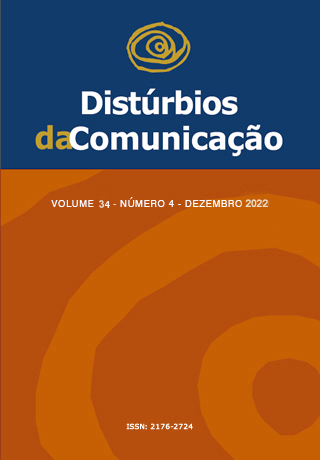Experience report of speech therapy in telehealth with neurological patients with dysphagia and dysarthria during the Covid-19 pandemic
DOI:
https://doi.org/10.23925/2176-2724.2022v34i4e55985Keywords:
Telemedicine, Dysarthria, Deglutition Disorders, Social Isolation, Coronavirus InfectionsAbstract
Introduction: Due to COVID-19, patients with neurological disease no longer attend face-to-face speech therapy consultations in outpatient clinics. Objective: To describe the report of the speech therapy experience patients with neurological disease with dysarthria and/or dysphagia during the COVID-19 pandemic through telehealth. Method: This is an experience report. Patients from the speech therapy outpatient clinic of a university hospital who were deprived of speech therapy during a pandemic period and had a diagnosis of dysphagia and/or dysarthria (prior to the pandemic) were included. In total, 43 patients were invited to participate in the study. Individuals were separated according to their speech-language diagnosis: dysphagia, dysarthria, and dysphagia/dysarthria. In the beginning, all were reassessed in video calls: dysphagia (Northwestern dysphagia patient check sheet, Functional Oral Intake Scale, and Food Self-Assessment Instrument); dysarthria (speech collection and self-perception questionnaire Radbould Oral Motor Inventory for Parkinson’s disease). Afterward, the patients were randomly allocated: speech therapy telecare for four consecutive weeks, with the other being a control group, without interventions and/or guidance. All were reassessed for comparison before and after speech therapy follow-up. Results: Nine participants completed all stages of the study, 6 (66.66%) men. The mean age was 60.44 years (±16.13). Participants had a medical diagnosis of neurological disease, 2 of which were neurogenetic (22.22%), five neurodegenerative (55.5%), and two neurologic (22.22%). No descriptive differences were observed between groups in pre- and post-intervention assessments. The loss in the sample happened due to the lack of technological devices and the overload of caregivers. Conclusions: The experience in telehealth was positive, revealing the difficulty of its implementation in neurological patients with low socio-financial and educational conditions.
Downloads
References
Esakandari H, Nabi-Afjadi M, Fakkari-Afjadi J, Farahmandian N, Miresmaeili SM, Bahreini E. A comprehensive review of COVID-19 characteristics. Biol Proced Online. 2020 Aug 4; 22: 19. doi: 10.1186/s12575-020-00128-2. PMID: 32774178; PMCID: PMC7402395.
World Health Organisation (WHO). “WHO, Coronavirus disease 2019 (COVID-19) Situation Report–107”. 2020. [Acesso em Mar 2021]. Disponível em: https://apps.who.int/iris/handle/10665/332061.
Jani MP, Gore GB. Occurrence of communication and swallowing problems in neurological disorders: analysis of forty patients. Neuro Rehabilitation. 2014; 35(4): 719-27. doi: 10.3233/NRE-141165.
Wirth R, Dziewas R. Neurogene Dysphagie [Neurogenic dysphagia]. Internist (Berl). 2017 Feb; 58(2): 132-140. German. doi: 10.1007/s00108-016-0178-8.
Enderby P. Disorders of communication: dysarthria. In: Barnes MP, Good DC. Handbook of Clinical Neurology. Elsevier Electronics (Switzerland), Volume 10, 2013.
Brasil. Resolução CFFa nº 427, de 1º de março de 2013. Dispõe sobre a regulamentação da Telessaúde em Fonoaudiologia e dá outras providências. Brasilia, DF.
Celes RS, Rossi TRA, de Barros SG, Santos CML, Cardoso C. A telessaúde como estratégia de resposta do Estado: revisão. Rev Panam Salud Publica. 2018; 42: e84. doi: 10.26633/RPSP.2018.84
Dorsey ER, Topol EJ. Telemedicine 2020 and the next decade. Lancet. 2020; 395(10227): 859. doi: 10.1016/S0140-6736(20)30424-4.
Kruse CS, Karem P, Shifflett K, Vegi L, Ravi K, Brooks M. Evaluating barriers to adopting telemedicine worldwide: a systematic review. J Telemed Telecare. 2018; 24(1): 4-12. doi: 10.1177/1357633X16674087.
Burns CL, Ward EC, Gray A, Baker L, Cowie B, Winter N et al. Implementation of speech pathology telepractice services for clinical swallowing assessment: An evaluation of service outcomes, costs and consumer satisfaction. J Telemed Telecare. 2019 Oct;25(9): 545-551. doi: 10.1177/1357633X19873248.
Fong R, Tsai TF, Yiu Oy. Telemed J E Health. 2021;27(1):30-38. doi: 10.1089/tmj.2020.0223.
Dimer NA, Soares NC, Santos LT, Goulart BN. Pandemia do COVID-19 e implementação de telefonoaudiologia para pacientes em domicílio: relato de experiência. CoDAS, 2020; 32(3), e20200144. doi: 10.1590/2317-1782/20192020144.
Logemann JA, Veis S, Colangelo L. A screening procedure for oropharyngeal dysphagia. Dysphagia. 1999 Winter;14(1): 44-51. doi: 10.1007/PL00009583.
Eisenstadt ES. Dysphagia and aspiration pneumonia in older adults. J Am Acad Nurse Pract. 2010; 22(1):17-22. doi: 10.1111/j.1745-7599.2009.00470.x.
Miles A, Connor NP, Desai RV, Jadcherla S, Allen J, Brodsky M, Garand KL, Malandraki GA, McCulloch TM, Moss M, Murray J, Pulia M, Riquelme LF, Langmore SE. Dysphagia Care Across the Continuum: A Multidisciplinary Dysphagia Research Society Taskforce Report of Service-Delivery During the COVID-19 Global Pandemic. Dysphagia. 2021 Apr;36(2):170-182. doi: 10.1007/s00455-020-10153-8. Epub 2020 Jul 11. PMID: 32654059; PMCID: PMC7353832.
Furkim AM, Sacco ABF. Eficácia da fonoterapia em disfagia neurogênica usando a escala funcional de ingestão por via oral (FOIS) como marcador. Rev CEFAC. 2008;10(4);503-12. doi: 10.1590/S1516-18462008000400010.
Gonçalves MIR, Remaili CB, Behlau M. Equivalência da versão brasileira do Eating Assessment Tool - EAT-10. CoDAS. 2013; 25:601-4. doi: 10.1590/S2317-17822013.05000012
Presotto M, Olchik MR, Kalf JG, Rieder CRM.Translation, linguistic and cultural adaptation, reliability and validity of the Radboud Oral Motor Inventory for Parkinson’s Disease – ROMP questionnaire. Arq Neuro-Psiquiatr. 2018; 76(5): 316-23. doi: 10.1590/0004-282X20180033.
De Paiva KM, Xavier IC, Farias N. Envelhecimento e Disfagia: Uma questão de Saúde Pública. Journal of Aging and Innovation. 2012; 1(6): 56-67.
BRASIL. Ministério da Saúde. Entendendo o SUS. Brasília, 2006. [Acesso em Mar 2021]. Disponível em: bvsms.saude.gov.br/bvs/publicacoes/entendendo_o_sus.pdf
Chor, Dóra. (2013). Desigualdades em saúde no Brasil: é preciso ter raça. Cadernos de Saúde Pública, 29(7), 12721275. https://dx.doi.org/10.1590/S0102-311X2013000700002.
Theodoros D, Russel TG, Hill A, Cahill L, Clark K. Assessment of motor speech disorders online: a pilot study. J Telemed Telecare. 2003; 9 Suppl 2: S66-8. doi: 10.1258/135763303322596318.
Downloads
Published
Issue
Section
License
Copyright (c) 2023 Rafaela Soares Rech, Annelise Aires, Iasmin Klein, Nathália Vescia Bauer, Maiara Laís Mallmann Kieling, Juliana Costa dos Santos, Laura Battistin Schiavoni, Vanessa Brzoskowski dos Santos, Verônica Salazar Moreira, Bruna Graciele Souza Alós, Maira Rozenfeld Olchik

This work is licensed under a Creative Commons Attribution 4.0 International License.









